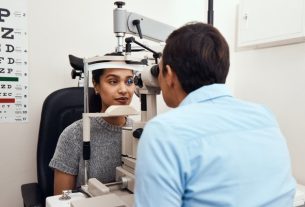Cataract is the clouding of the crystalline lens, which is the natural lens of the eye that allows objects to be focused, which makes it difficult for light to pass to the retina, causing symptoms such as blurred vision, halos around the light or progressive loss of vision.
The main cause of cataracts is the natural aging of the lens and, therefore, is more common in the elderly, however, it can also be caused by diabetes, use of corticosteroid eye drops, blows, eye infection or smoking, for example.
It is important to consult an ophthalmologist whenever cataract symptoms appear to confirm the diagnosis and begin appropriate treatment, which is usually done with surgery to remove the affected lens and place an artificial lens that restores vision.

Cataract symptoms
The main symptoms of cataracts are:
- Difficulty seeing and perceiving images;
- Seeing distorted people with blurred and misshapen contours;
- See duplicate objects and people;
- Blurry vision;
- Sensation of seeing light shining more intensely and with the formation of halos, which may worsen at night;
- Increased sensitivity to light;
- Difficulty distinguishing colors well and identifying similar tones;
- Frequent changes in glasses prescription.
These symptoms can appear together or separately, and affect one or both eyes, and must be evaluated by an ophthalmologist so that the diagnosis can be made and appropriate treatment can be established.
In more advanced cases, cataracts can also lead to the appearance of a white spot in the eye.
Read too: 11 symptoms of eye problems
Online symptom test
If you think you may have cataracts, select what you are experiencing to find out the chances:
The test is a guidance tool and does not serve as a diagnosis or replace a consultation with an ophthalmologist.
How to confirm the diagnosis
The diagnosis of cataract is made by an ophthalmologist by analyzing symptoms, health history and medication use and an ophthalmological examination.
Make an appointment with an ophthalmologist in the region closest to you:
Taking care of your health has never been easier!
By examining the eyes with a device called a slit lamp, the doctor can identify the exact location and extent of the cataract. Find out more about the ophthalmological exam.
In the case of babies and children, it is important to inform the doctor of the signs that the child may have cataracts, such as difficulty looking directly at an object or a white spot in the eye or in photos.
Possible causes
Cataracts are caused because the lens of the eye becomes less transparent, less flexible and thicker, making it difficult for light to pass to the retina, resulting in symptoms.
Some factors can increase the risk of cataracts, such as:
- Natural aging of the lens in the eye, being more common in the elderly;
- Excessive exposure to radiation;
- Trauma to the eye, such as blows or injuries with penetrating objects;
- Diabetes or hypothyroidism;
- Infections or inflammations in the eye, such as uveitis;
- Prolonged use of corticosteroid eye drops.
Furthermore, both glaucoma itself and its treatment can lead to cataracts, as can pathological myopia or eye surgery.
Other factors that can also increase the risk of cataracts include excessive alcohol consumption, smoking, family history of early cataracts, high blood pressure, obesity and other metabolic disorders, for example.
Types of cataract
Cataracts can be classified into several types according to their cause, which includes
1. Senile cataract
Senile cataracts are related to age, generally appear after the age of 50 and occur due to the body’s natural aging process.
This type of cataract can affect the center of the lens, called a nuclear cataract, or the lateral regions of the lens, in which case it is called a cortical cataract.
In addition, senile cataracts can also affect the posterior capsule of the lens. It is generally associated with diabetes or the use of medications such as corticosteroids, and is known as posterior subcapsular cataract.
2. Congenital cataract
Congenital cataract is a type of cataract present from birth, and may arise due to malformations in the baby’s eye, maternal infections during pregnancy, or syndromes, such as Down syndrome, for example. Learn more about congenital cataracts.
3. Traumatic cataract
Traumatic cataracts can occur in anyone due to an accident, injury or trauma to the eyes, such as punches, blows or objects penetrating the eyes, for example.
This type of cataract usually does not occur immediately after trauma and can take up to years to develop.
4. Secondary cataract
Secondary cataracts occur due to diseases such as diabetes or hypothyroidism or the use of medications such as corticosteroids, for example. It is important to maintain medical monitoring for these diseases and to use medications to reduce the risk of developing cataracts.
How the treatment is carried out
Cataract treatment must be carried out under the guidance of an ophthalmologist and varies according to the severity of the symptoms and difficulty in carrying out daily activities.
Therefore, the use of glasses or corrective lenses may be recommended to correct vision, or lubricating eye drops to reduce discomfort in the eyes.
However, the only treatment capable of curing cataracts is surgery in which the affected lens is removed from the eye and replaced with an intraocular lens (IOL). I knew how cataract surgery is performed and what recovery is like.
How to prevent cataract
Some precautions can help prevent the appearance of cataracts or prevent them from worsening, such as:
- Have regular eye exams;
- Do not use eye drops or take medications, especially corticosteroids, without medical advice;
- Wear sunglasses to reduce exposure to ultraviolet radiation;
- Quit smoking;
- Reduce the consumption of alcoholic beverages;
- Control diabetes;
- Maintain ideal weight.
Furthermore, it is important to maintain a healthy diet rich in vitamins A, B12, C and E, minerals such as calcium, phosphorus and zinc and antioxidants such as omega 3 present in fish, algae and seeds such as chia and linseed, for example, as they can help to prevent changes in the eyes due to natural aging.

Sign up for our newsletter and stay up to date with exclusive news
that can transform your routine!
Warning: Undefined array key "title" in /home/storelat/public_html/wp-content/plugins/link-whisper-premium/templates/frontend/related-posts.php on line 12
Warning: Undefined array key "title_tag" in /home/storelat/public_html/wp-content/plugins/link-whisper-premium/templates/frontend/related-posts.php on line 13



